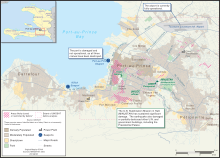2010 earthquake
Main article: 2010 Haiti earthquake
On 12 January 2010, a 7.0 earthquake struck Port-au-Prince, devastating the city. Most of the central historic area of the city was destroyed, including Haiti's prized Cathédrale de Port-au-Prince, the capital building, Legislative Palace (the parliament building), Palace of Justice (Supreme Court building), several ministerial buildings, and at least one hospital.[8] The second floor of the Presidential Palace was thrown into the first floor, and the domes skewed at a severe tilt. The seaport and airport were both damaged, limiting aid shipments. The seaport was severely damaged by the quake[9] and was unable to accept aid shipments for the first week. The airport's control tower was damaged[10] and the US military had to set up a new control center with generators to get the airport prepared for aid flights. Aid has been delivered to Port-au-Prince by numerous nations and voluntary groups as part of a global relief effort. On Wednesday, January 20, 2010, an aftershock rated at a magnitude of 5.9 caused additional damage.[11]
[edit]Geography
The metropolitan area is subdivided into various districts (communes). There is a ring of districts that radiates out from the commune of Port-au-Prince. Pétionville is an affluent suburban commune located southeast of the city. Delmas is located directly south of the airport and north of the central city, and the rather poor commune of Carrefour is located southwest of the city. Port-au-Prince commune harbors many low-income slums plagued with poverty and violence in which the most notorious, Cité Soleil is situated. However, Cité Soleil has been recently split off from Port-au-Prince proper to form a separate commune. The Champ de Mars area has begun some modern infrastructure development as of recently. The downtown area is the site of several projected modernization efforts in the capital.
[edit]Climate
Port-au-Prince has a tropical wet and dry climate and relatively constant temperatures throughout the course of the year. Port-au-Prince’s wet season runs from March through November, though the city experiences a relative break in rainfall during the month of July. The city’s dry season covers the remaining three months. Port-au-Prince generally experiences warm and humid conditions during the dry season and hot and humid conditions during the wet season.
| [hide]Climate data for Port-au-Prince | |||||||||||||
|---|---|---|---|---|---|---|---|---|---|---|---|---|---|
| Month | Jan | Feb | Mar | Apr | May | Jun | Jul | Aug | Sep | Oct | Nov | Dec | Year |
| Average high °C (°F) | 31 (88) | 31 (88) | 32 (90) | 32 (90) | 33 (91) | 35 (95) | 35 (95) | 35 (95) | 34 (93) | 33 (91) | 32 (90) | 31 (88) | 32.8 (91.2) |
| Daily mean °C (°F) | 27 (81) | 26.5 (79.7) | 27 (81) | 28 (82) | 28 (82) | 30 (86) | 30 (86) | 29.5 (85.1) | 28 (82) | 28 (82) | 27 (81) | 26.5 (79.7) | 27.96 (82.29) |
| Average low °C (°F) | 23 (73) | 22 (72) | 22 (72) | 23 (73) | 23 (73) | 24 (75) | 25 (77) | 24 (75) | 24 (75) | 24 (75) | 23 (73) | 22 (72) | 23.3 (73.8) |
| Rainfall mm (inches) | 33 (1.3) | 58 (2.28) | 86 (3.39) | 160 (6.3) | 231 (9.09) | 102 (4.02) | 74 (2.91) | 145 (5.71) | 175 (6.89) | 170 (6.69) | 86 (3.39) | 33 (1.3) | 1,353 (53.27) |
| Avg. rainy days (≥ 1 mm) | 3 | 5 | 7 | 11 | 13 | 8 | 7 | 11 | 12 | 12 | 7 | 3 | 99 |
| Mean monthly sunshine hours | 279.0 | 254.2 | 279.0 | 273.0 | 251.1 | 237.0 | 279.0 | 282.1 | 246.0 | 251.1 | 240.0 | 244.9 | 3,116.4 |
| Source: Climate & Temperature [12] | |||||||||||||





No comments:
Post a Comment